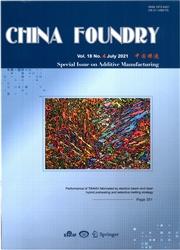Elastic-viscoplastic constitutive equations of K439B superalloy and thermal stress simulation during casting process
IF 2.3
3区 材料科学
Q2 Materials Science
引用次数: 0
Abstract
K439B nickel-based superalloy is a new type of high-temperature material. There is insufficient research on its constitutive equations and numerical modeling of thermal stress. Isothermal tensile experiments of K439B superalloy at different temperatures (20 °C–1,000 °C) and strain rates (1.33×10−3 s−1–5.33×10−3 s−1) were performed by using a Gleeble-3800 simulator. The elastic moduli at different temperatures (20 °C–650 °C) were measured by resonance method. Subsequently, stress-strain curves were measured for K439B superalloy under different conditions. The elastic-viscoplastic constitutive equations were established and the correspongding parameters were solved by employing the Perzyna model. The verification results indicate that the calculated values of the constitutive equations are in good agreement with the experimental values. On this basis, the influence of process parameters on thermal stress was investigated by numerical simulation and orthogonal experimental design. The results of orthogonal experimental design reveal that the cooling mode of casting has a significant influence on the thermal stress, while pouring temperature and preheating temperature of shell mold have minimal impact. The distribution of physical fields under optimal process parameters, determined based on the orthogonal experimental design results, was simulated. The simulation results determine separately the specific positions with maximum values for effective stress, plastic strain, and displacement within the casting. The maximum stress is about 1,000.0 MPa, the plastic strain is about 0.135, and the displacement is about 1.47 mm. Moreover, the distribution states of thermal stress, strain, and displacement are closely related to the distribution of the temperature gradient and cooling rate in the casting. The research would provide a theoretical reference for exploring the stress-strain behavior and numerical modeling of the effective stress of the alloy during the casting process.K439B高温合金弹粘塑性本构方程及铸造过程热应力模拟
K439B镍基高温合金是一种新型高温材料。目前对其本构方程和热应力数值模拟研究不足。采用Gleeble-3800模拟装置,对K439B高温合金在不同温度(20°C - 1000°C)和应变速率(1.33×10−3 s−1-5.33×10−3 s−1)下的等温拉伸实验进行了研究。用共振法测量了不同温度(20℃~ 650℃)下的弹性模量。随后,测量了不同条件下K439B高温合金的应力-应变曲线。采用Perzyna模型建立了弹粘塑性本构方程,并求解了相应的参数。验证结果表明,本构方程计算值与实验值吻合较好。在此基础上,通过数值模拟和正交试验设计研究了工艺参数对热应力的影响。正交试验设计结果表明,铸件冷却方式对热应力影响显著,浇注温度和壳型预热温度对热应力影响最小。在正交试验设计结果的基础上,对最佳工艺参数下的物理场分布进行了模拟。模拟结果分别确定了铸件内有效应力、塑性应变和位移的最大值的具体位置。最大应力约为10000.0 MPa,塑性应变约为0.135,位移约为1.47 mm。此外,热应力、应变和位移的分布状态与铸件内温度梯度和冷却速率的分布密切相关。该研究可为探索铸造过程中合金的应力-应变行为及有效应力的数值模拟提供理论参考。
本文章由计算机程序翻译,如有差异,请以英文原文为准。
求助全文
约1分钟内获得全文
求助全文
来源期刊

China Foundry
工程技术-冶金工程
CiteScore
2.10
自引率
25.00%
发文量
1646
审稿时长
3.0 months
期刊介绍:
China Foundry, published bimonthly to a worldwide readership, mainly reports on advanced scientific and technical achievements, applied technology, production successes, management and leadership, recent developments and industry information in the foundry field. Coverage encompasses all casting technologies and includes, but is not limited to, novel and net shape casting technologies; casting alloy design and modification; control of nucleation, solidification and microstructure & mechanical properties; computer aided design; rapid prototyping; mold making, mold materials and binders; mold and gating design; melting and liquid-metal treatment and transport; modeling and simulation of metal flow and solidification; post-casting treatments; quality control and non-destructive testing; process automation and robotics; and safety and environmental issues.
 求助内容:
求助内容: 应助结果提醒方式:
应助结果提醒方式:


